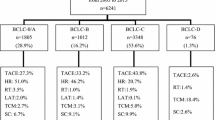Abstract
Objective
To observe the efficacy of Chinese medicine comprehensive therapeutic project in treating the middle/late stage primary hepatic carcinoma (PHC).
Methods
With prospective randomized controlled design, 97 patients with PHC were assigned to the test group (49 cases) treated with Chinese medicine comprehensive therapy using Oleum fructus bruceas intervention combining oral intake of Ganji Decoction (肝积方) and external application of Ailitong (癌理通), and the control group (48 cases) treated with chemotherapeutic agents combining iodized oil chemo-embolization and analgesics. The immediate and long-term efficacy, adverse reaction, pain-relieving initial time (PRIT) and pain-relieving sustained time (PRST) of the treatment, as well as the change in relieving patients’ quality of life (QOL) were observed.
Results
The difference between the two groups in illness control rate was statistically insignificant (P>0.05), but the adverse reaction occurence rate in the test group was lesser than that in the control group (P<0.05). PRIT was insignificantly different in the two groups (P>0.05), but the PRST was significantly superior in the test group than that in the control group (10.37±2.18 h vs 7.78±1.95 h, P<0.01). After treatment, the increased Karnofsky scores in the test group indicated that the patients’ somatic activity, symptoms and QOL were improved significantly, which were significantly superior to those in the control group (P<0.05). The survival rate in the two groups was similar at the 3rd month after treatment, but the test group did show superiority in terms of half- and 1-year survival rate (65.9% vs 42.5% and 38.6% vs 18.1%, respectively, P<0.05). The median survival time in the test group was 8.9 months and that in the control group was 5.3 months.
Conclusion
Chinese medicine comprehensive therapy is an effective treatment for the middle/late stage patients of PHC, and it could extend the PRST, improve the patients’ QOL and long-term survival with less adverse reaction.
Similar content being viewed by others
References
National Cancer Prevention and Control Office, Chinese Anti-cancer Association. Standardized diagnosis and treatment of common malignant tumors in China. Volume 2. Beijing: Joint Press of Beijing Medical University and Peking Union Medical College, 1990:54–55.
Sun Y, ed. Medical oncology. Beijing: People’s Medical Publishing House, 2001:995–996.
Wang CH, Fang JQ, Zhang CZ, Lin Y, Luo YM. Establishment and evaluation of measuring scale of QOL on hepatoma. Chin J Behav Med (Chin) 1998;37:170–173.
Ko KH, Jo M, Lee JH. Antiinflammatory and analgesic activities, and slin irritation test of piroxicam patch. J Appl Pharmacol 1994;2:71–76
Liu LM, Yang YF, eds. Grababin medicinarum particularum of oncology. Beijing: People’s Medical Publishing House, 2003:651–652.
Jiang WQ, Sun XF, Zhang L, Huang HQ. Practical manual of prescription on oncology. Guangzhou: Guangdong Science and Technology Press, 2003:524–528.
Yamada R, Sato M, Kawabata M. Hepatic artery embolization in 120 patients with unresectable hepatoma. Radiology 1983;148:397.
Chen XM, Luo PF, Hu JL, Shao PJ, Zhou ZJ. Delayed adverse reactions of liver after transcatheter hepatic arterial chemoembolization with anticancer drugs mixed lipiodol. Cancer (Chin) 1994;13:50–52.
Gao QY. Prospective, controlled study of chemoembolization expectant treatment on hepatoma. Foreign Med Sci (Oncol Sec, Chin) 1995;22:313.
Wang F, Cao Y, Liu HY, Fu ZD, Han R. Study of Brucea javanica oil emulsion induced HL-60 cell apoptosis. Chin J Tradit Chin Med (Chin) 2003;28:759–762.
Wang H, Zhang B, Wu GJ, Zhang G, Xin JG. Brucea mouse anticancer at the role of bladder cancer. J Fourth Milit Med Univ (Chin) 2001;22:1886.
Lin HY, Wu JM, Zhang WS. Study progress of oleum fructus bruceae. Chin J Exp Pharmacol Tradit Chin Med Form (Chin) 2006;12:65–69.
Li WJ, Deng L, Ai LX, Li JP. Oleum of brucea javanicalipidol used in hepatic arterial embolization to treat hepatocellular carcinoma: an effect analysis. Imag Diagn intervent radiol (Chin) 2005;14:30–31.
Ma L, Zhang YN. Effects of seminal oil emulsion of Brucea javanica on apoptosis and apoptosis-related genes in human hepatocellular carcinoma cells. World Chin J Digestol (Chin) 2004;12:559–562.
Wu WY. The application of Chinese medicine in interventional transcatheter arterial treatment of liver cancer. Chin J Integr Tradit West Med Liver Dis (Chin) 1998;8:188–191.
Shen YJ, Chen CX, eds. Pharmacology of traditional Chinese medicine. Shanghai: Shanghai Science and Technology Press; 2008: 58–61, 125–127, 320–324.
Huang XQ, Tian HQ, Liang GW. Affection of the drug of Ganjifang containing serum to the hepG2 cell proliferation. Chin J Pract Med (Chin) 2006;19:2613–2615.
Chen XZ, Tian HQ, Huang XQ, Liang GW, Huang ZQ. Effect of Ganjifang to blood stasis of patients with advanced PLC. Shaanxi Tradit Chin Med (Chin) 2005;26:891–893.
Tian HQ, Xu XQ, Liang GW, Huang ZQ, Deng JM. Effect of Ganjifang to SIL-2R and T cells of patients with advanced PLC. Chin J Mod Med (Chin) 2001;11(10):89–90.
Tian HQ, Liang GW, Huang XQ, Huang ZQ. Effect of Ganjifang combined with Argon-helium cryoablation and TACE treating 48 patients with advanced PLC. New J Tradit Chin Med (Chin) 2005;37:21–22.
Tian HQ, Liang GW, Tao Y, Huang ZQ, Yu SY, Ye WY. Interventional treatment of liver cancer with traditional Chinese medicine clinical research. Henan J Tradit Chin Med (Chin) 2001;16:47–48.
Liu JX, Xu DF, Fang ZZ. Effect of Chansu Ointment for cancer pain. J Tradit Chin Med (Chin) 1993;34:281–282.
Author information
Authors and Affiliations
Corresponding author
Additional information
Supported by Guangdong Administration of Sciences and Technology (No. 2005B36001012)
Rights and permissions
About this article
Cite this article
Tian, Hq., Li, Hl., Wang, B. et al. Treatment of middle/late stage primary hepatic carcinoma by Chinese medicine comprehensive therapy: A prospective randomized controlled study. Chin. J. Integr. Med. 16, 102–108 (2010). https://doi.org/10.1007/s11655-010-0102-3
Received:
Published:
Issue Date:
DOI: https://doi.org/10.1007/s11655-010-0102-3




